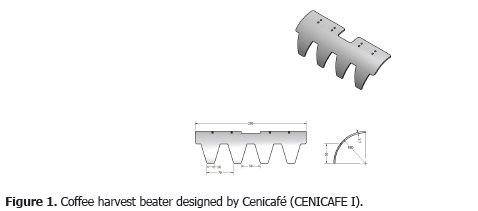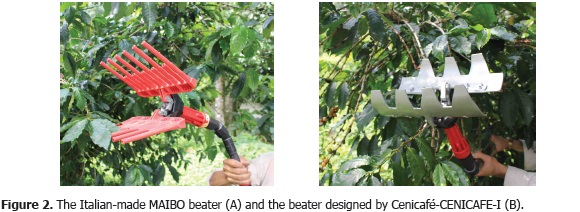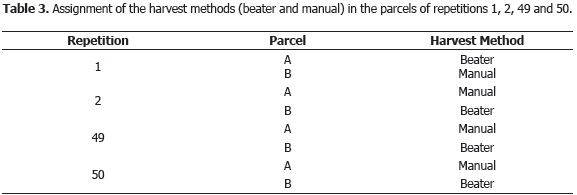Serviços Personalizados
Journal
Artigo
Indicadores
-
 Citado por SciELO
Citado por SciELO -
 Acessos
Acessos
Links relacionados
-
 Citado por Google
Citado por Google -
 Similares em
SciELO
Similares em
SciELO -
 Similares em Google
Similares em Google
Compartilhar
Revista Facultad Nacional de Agronomía Medellín
versão impressa ISSN 0304-2847
Rev. Fac. Nac. Agron. Medellín vol.66 no.1 Medellín jan./jun. 2013
Evaluation of Mechanical Beaters in Coffee Harvesting
Evaluación de Batidores Mecánicos en la Cosecha del Café
Fernando Álvarez Mejía1; Carlos Eugenio Oliveros Tascón2 and Juán Rodrigo Sanz Uribe3
1 Titular Professor. Universidad Nacional de Colombia - Sede Medellín - Facultad de Ciencias Agrarias. Departamento de Ingeniería Agrícola y Alimentos. A.A. 1779, Medellín, Colombia.<falvarezme@unal.edu.co>
2 Principal Researcher. Centro Nacional de Investigaciones de Café - CENICAFE. Planalto km 4 vía Chinchiná - Manizales, Caldas, Colombia. <carlos.oliveros@cafédecolombia.com>
3 Senior Researcher. Centro Nacional de Investigaciones de Café - CENICAFE. Planalto km 4 vía Chinchiná - Manizales, Caldas, Colombia.<juanr.sanz@cafedecolombia.com>
Recibido: Junio 22 de 2012; aceptado: Noviembre 21 de 2012.
Abstract
Two portable devices were evaluated for coffee harvesting. The Italian-made MAIBO beater (harvest tool), used for coffee harvesting in Brazil, and the beater designed by Cenicafé (CENICAFE-I), which removes fruits by applying pressure to the clusters that have a higher content of ripe fruits. The research was conducted in two stages. In the first, the two beaters were compared using 60 experimental units of seven trees each. The CENICAFE-I beater presented the better quality in the harvested coffee and used an equal amount of time per tree. In the second stage, the performance of the CENICAFE-I beater was compared with the traditional manual method, using an commutative experimental design with 50 plots (replicates) of 14 trees each; randomly assigning seven trees in each plot to each method. The CENICAFE-I beater, without a manual resweep, increased the operational yield by 305.7% as compared to that of the traditional manual method. With an immediate, manual resweep, the operational yields were equal for the two methods. The quality of the coffee collected with the CENICAFE-I was lower than that of manual harvesting and was not acceptable by Colombian standards. In order to reduce the cost of harvesting by 10% when using a pneumatically actuated CENICAFE-I beater, one must achieve yields greater than 40 kg h-1 or 60 kg h-1 when operating 400 or 200 h/year, respectively.
Key words: Semi-mechanized harvest, coffee harvest, beaters, pneumatic harvester.
Resumen
Se evaluaron dos dispositivos portátiles en la cosecha del café. El batidor MAIBO de fabricación italiana, utilizado en Brasil en la cosecha del café y un batidor diseñado en Cenicafé (CENICAFE-I) para desprender frutos comprimiendo los glomérulos que presenten mayor concentración de frutos maduros. La investigación se realizó en dos etapas. En la primera, se compararon los dos batidores utilizando para cada uno 60 unidades experimentales, de siete árboles cada una. Se seleccionó al batidor CENICAFE-I por presentar mejor calidad de café recolectado e igual tiempo empleado por árbol. En la segunda etapa, se comparó el desempeño en cosecha del batidor CENICAFÉ-I con el método manual tradicional, utilizando un diseño experimental conmutativo, con 50 parcelas (repeticiones) de 14 árboles cada una, asignando aleatoriamente siete árboles a cada método en cada parcela. Con el batidor CENICAFÉ-I sin repase manual se incrementó el rendimiento operativo en un 305,7% con relación al observado con el método manual tradicional. Con repase manual inmediato los rendimientos operativos fueron iguales con ambos dispositivos. La calidad del café recolectado con el batidor CENICAFE-I fue inferior a la obtenida con la cosecha manual y no es aceptable para los estándares colombianos. Para disminuir un 10% el costo de la recolección de café, utilizando el equipo CENICAFE-I accionado neumáticamente, se requiere alcanzar rendimientos superiores a 40 kg h-1 y 60 kg h-1, con tiempos de trabajo de 400 y 200 h/ año, respectivamente.
Palabras clave: Cosecha semi-mecanizada, cosecha de café, batidores, cosechadores neumáticos.
Colombia produces coffee on the slopes of three mountain ranges and the Sierra Nevada de Santa Marta, predominantly at altitudes of 1,000-2,000 masl. There are soils of sandy to clayey, with terrains that range from flat to undulating (slope less than 25%) to steep (slope greater than 75%); and most are of volcanic origin with different degrees of evolution.
The climate is determinant in the distribution of the coffee harvest: a dry period, pronounced in the early part of the year, characterizes the regions of the north and gives rise to a single harvest between October and December; the regions with two periods of lower rainfall/year (central region) produce two crops, the principal one is October to December and the second one is April to June; and in the southern zone the midyear dry period leads to a harvest between April and June (Gómez et al., 1991).
Harvesting is done by hand, collecting mature fruits that present in clusters, which only occasionally contain more than 50% mature fruits (Oliveros et al., 2005; Diaz et al., 2009); four-year-old trees of the Castillo® variety have averaged 54 branches of 68 cm in length (Alvarado and Ochoa, 2006). The distance between the rows varies from 1.0 to 1.5 m. The average yield at harvest, according to Duke and Dussan (2004), is 82.6 kg/day. The price paid at harvest depends on several factors, including the supply of mature fruits at collection, which, according to Ramírez (1998); López et al. (2006); Ramírez et al. (2006) and in the "peak" days of the harvest, can vary from 500 to 700 g of mature fruits/tree.
In Colombia and in other producing countries, different collecting technologies have been evaluated in order to increase efficiency and reduce labor costs, using portable and fully mechanized equipment (Wang, 1968; Philips, 1970; Goyal and Rivera, 1987; Kashima, 1995; Norris, 1995; Monroe and Silva, 2004; Ramírez et al., 2006). The technologies that are currently used in other countries for coffee harvesting require conditions not present on the plantations of Colombia, such as row spacing greater than 2.5 m, slopes up to 30%, low rainfall in the days of harvest and, mainly, a immature fruit percentage at the moment of collection of less than 20%.
Mechanical beaters are portable, pneumatically driven equipment, which are used in Mediterranean countries, mainly Italy, to reduce the costs of olive harvesting (Tombesi et al., 1997). The operating pressure is generally in the range of 8 to 12 bar; the air flow for each beater varies between 180 and 220 liters/minute. The beater may be located at a distance of 100 m from the compressor, which can be operated by a stationary engine or tractor.
Snoeck et al. (1976) evaluated harvest yield with mechanical beaters built by the Italian firm Agromatica in a 42-month-old coffee crop of the Robusta variety in the Ivory Coast, Africa; clone 182, with high uniform maturity characteristics and multiple stems. The nylon beaters, with two applications simultaneously, consisted of two elements, each having three or four nylon rods 40 cm in length. The beaters were actuated by a flow of 220 liters per minute of air supplied by a 2.6 kW compressor. According to the results obtained by Snoeck et al. (1976), in general, the percentages of immature harvested mass with the Agromatica equipment ranged from 3.5 to 8.6%, similar to those obtained with manual collection. Collection costs with the mechanical beaters were 17.4% higher than manual collection.
Beaters are used for coffee harvesting in Brazil, Silva et al. (1997), on farms located in mountainous areas of Minas Gerais, with high density coffee cultivation and smaller plantations, which, according to the authors, have reduced manual labor by at least 25% and collection costs by 14%.
Barros et al. (1995), cited by Silva et al. (1997), in tests comparing Agromatica mechanical beaters to manual labor, obtained: an increase in yield of 80%, an efficacy of 90%, and mechanical damage (broken branches) exceeding 40%. Defoliation was similar in both coffee collection methods.
Silva et al. (1998) evaluated the coffee harvest with mechanical beaters on three plantations in Minas Gerais (Brazil), cultivated with the Mundo Novo variety with ages of 5, 10 and 12 years and planting patterns of 4.0 m x 0.7 m, 3.8 m x 0.7 m and 3.5 m x 2.0 m; two stems per site, and on slopes of 4, 7 and 15%. The percentage of immature fruits at harvest time were 33.5, 12.5 and 32.0%, respectively. A 5.22 kW compressor actuated the beaters, which discharged 600 liters/min of air at a pressure of 10 bar, which allowed two beaters to operate simultaneously. The beaters, as with manual harvest, were operated two at time on the same tree (one on each side). At a working pressure of 7 bar, the frequency of the beaters was 900 cpm. According to the authors, the mechanical beaters made more effective use of labor in the coffee harvest on the farm conditions evaluated in Minas Gerais (Brazil), the need for which was reduced by between 27 and 56%.
In Colombia, Herrón (1996) reported results from Agromatica beaters in 6-year-old coffee plots of the Caturra variety, planted at 1 m x 1 m. In plot No. 1, the slope was 20% and the degree of maturation 25%. In plot No. 2, the slope was 12% and the maturation percentage 40%. The mechanical beaters were employed on all branches that had coffee. The results of this evaluation were: high percentage of immature harvested cherry mass in both groups (50%); high defoliation (above 40%); 100% flower and forming bean detachment; beans close to the trunk did not detach; manual resweeping was required to harvest the beans that were not detached by the beaters; there was difficulty in capturing detached beans, even in lots with relatively low slopes (10%); a team of two beaters required 5 workers. Based on the above results, this technology was not considered feasible for the coffee growing conditions in Colombia.
Oliveros (1996) evaluated the performance of a MAIBO brand mechanical beater with smaller impactors than the Agromatica equipment, each with 6 bars 155 mm in length and 5 bars 73 mm in length. The tests were conducted in two plots of 500 trees, planted with four-year-old Caturra and Colombia varieties with 1.0 m between trees in the same row and 2.0 m between rows. The slope in both plots was below 20%. To increase the concentration of ripe fruit and decrease the applied force for detachment, Ethrel (2-chloroethyl-phosphonic acid) was applied, 120 mg of commercial product/tree, 15 days before harvest with the MAIBO equipment. The equipment was operated at a pressure of 10 bars. The yields obtained were 32.1 and 25.1 kg h-1, in fields planted with v. Caturra and v. Colombia, respectively. The content of immature coffee in the harvested mass was between 19.4 and 29.1%, respectively, well above the maximum required limit (2.5%).
In order to adapt the beaters to the ripening conditions present in coffee cultivation in Colombia and facilitate their employment in times of increased harvest, the Italian equipment beaters were replaced with 290 mm long impactors, with teeth dimensions of 50 mm at the base and 20 mm at the end, using PVC pipe with a 114 mm (6Ë) diameter, cut longitudinally (Figure 1). With the new actuators, the clusters were compressed to detach the larger fruits, which generally require less force to detach than immature and unripe fruits.

The new beater, called CENICAFE-I, was evaluated in a laboratory at pressures of 5 and 7 bars (Oliveros, 1997). Branches were attached to a device that simulated the junction with a trunk. Before each trial, the percentage of mature, half-ripe and immature fruits present in each branch was determined. The clusters with the highest percentage of half-ripe and ripe fruits (fruits with physiological maturity) were beaten. The minimum time employed per branch was 0.39 s and the maximum 7.7 s. The lowest percentage of immature fruit was obtained with a working pressure of 5 bars for the CENICAFE-I beater.
The force with which the CENICAFE-I beats a bunch was determined in a laboratory by measuring the strain experienced by a stainless steel beam (14 mm wide, 6.35 mm thick and 180 mm in length) using a linear variable differential transformer (LVDT, with a range of 0 to 5 cm) placed at the end of the beam and a Sp 200 OMEGA signal processor. At a working pressure of 10 bar, the force at the end of the CENICAFE-I beater was 78.49 N and at 5 bars, 47.3 N; well above the values required to detach immature and ripe fruit at a tension of 8-10 N (Álvarez et al., 1999).
The purpose of this research was to technically and economically evaluate two beaters in coffee harvesting.
Materials and methods
Location. This research was conducted at the Estación Central Naranjal, of the Centro Nacional de Investigaciones de Café (Cenicafé), located at 4° 59' North latitude, 75° 39' West longitude, in Chinchiná (Caldas), at an altitude of 1,400 masl, with an average temperature and humidity of 20.8 °C and 78%, and annual rainfall of 2,656 mm; with the fourth harvest of v. Colombia crops, planted with a row spacing of 1.5 m and 1.0 m between plants, on slopes less than and two AW/M1 hose reels with 100 m of 6 x 8 hose 15%.
Materials. For the tests, a MAIBO BK/14MC compressor was used with beaters or "combs" made of nylon (Olistar model) with Olistar MT1 extenders and two AW/M1 hose reels with 100 m of 6 x 8 hose each (Figure 2). Technical details of the compressor are shown in Table 1.


The beaters used in the present study were as described by Table 2.

Additionally the study used: poly-shade mesh (50 m); one stopwatch; one balance with a range of 0-5 kg and sensitivity of 0.1 g; one balance with a range of 0-100 kg and sensitivity of 1 g.
Two stages were used to achieve the objective proposed in this research: first, the MAIBO and CENICAFE-I beaters were evaluated using poly-shade mesh to catch the fruits. In the second stage, we assessed the beater that had the best performance compared to manual harvesting.
First stage
Selecting the best beater. The collection team in charge of operating the beaters consisted of four people (two to operate the beaters and two for manually resweeping the trees, especially toward the bottom). The number of trees to be harvested in each work cycle was 7 (experimental unit).
The work cycle with each mechanical beater was composed of the following activities: place mesh in the rows of the collection, as close as possible to the tree trunk; striking the clusters of fruit with the beaters, mainly those with a higher proportion of mature fruits, two beaters acting simultaneously on each tree; manually resweeping the trees; collect the mesh; remove leaves and other light impurities; pack the coffee.
Operators, with a better than average performance in manual harvesting, were selected for the beaters, according to collection sheets. Before the tests were conducted, the operators were trained for the new harvest method.
The beaters were employed in three sweeps of the principal harvest at the Estación Central Naranjal. The experimental unit (EU) consisted of seven trees, in whose rows poly-shade meshs were placed to reap the detached fruits. The total number of experimental units employed for each beater was 60, twenty for each collection sweep. The experimental units were allocated as follows: at random for either equipment in the first experimental unit and then systematic alteration of the equipment.
Before harvesting the coffee in each EU, a tree was randomly selected (called the reference tree) to determine the number of ripe, half-ripe and immature fruits. With the information on the number of mature fruits, an inference was made of the number of mature fruits for harvesting in each EU, which was used as a covariate in the assessment of equipment performance.
After harvesting each EU, the reference trees were counted for the number of ripe, half-ripe and immature fruits without detachment. With this information, the proportion of detachment of ripe, half-ripe and immature fruits was determined for each EU as the ratio of the initial number of fruits less those left on the tree over the initial number of fruits.
In each EU, the time taken (minutes) for each activity and the mass (kg) of coffee collected were recorded in order to obtain the equipment performance per cycle (kg h-1). To evaluate the physical quality of the harvested coffee (percentage of mature, halfripe and immature fruits) for each EU, a sample of approximately 1.0 kg was taken.
In preliminary tests with mechanical beaters, it was found that there are two types of coffee losses: a) due to fruit thrown by beaters away from the planned collection and b) due to fruits that are not retained by the mesh in areas close to the stem of harvested trees. For quantification of the former, seven meter-long poly-shade mesh was placed in the rows around the work; the fruits were collected and weighed (Pfli, where i indicate the experimental unit). The latter, attributable to difficulties in the placement of mesh, was obtained by collecting and weighing the fruit deposited in the furrow of each tree (Pmi, where i indicates the experimental unit).
With the above information, the beaters were evaluated in four basic aspects (performance indicators): effectiveness, efficiency, quality and losses, through the mean ratio parameters of detachment, average yield, average proportion of mature harvested mass (physical quality) and average loss. To select the best beater, the performance indicators were compared according to a t-test at 5%.
Second stage
Comparison of the best beater with traditional hand harvesting. For this purpose, a group of four capable collectors was formed; homogeneous in manual collection performance, according to collection sheets and the field supervisor (known in Colombia as the cutting boss). This group worked with the two harvest methods, in the peak week of the principal harvest in 50 plots (replicates) of 14 trees. Each method was applied 50 times on parcels of seven trees (A and B), assigned randomly within each plot, according to a commutative experimental design, as shown in Table 3 for the first two and the last two parcels.

For each harvest method, mature fruit detachment (efficacy), quality of the harvested mass and losses were determined following the procedure described in the first stage. In each plot, a reference tree was selected to record mature fruits for harvesting. The coffee losses to the ground, with the traditional method, were determined in each plot by weighing the fruits retained in the poly-shade mesh placed in the rows.
To estimate the cost of coffee harvested with beaters ($ kg-1 of cherries), the methodology proposed by Philips (1970), was used, which considered fixed costs, variable costs, the effect (economic) caused by technology (coffee quality, mainly) and losses of coffee (non-detached fruit and fallen to the ground fruit).
The value of new equipment: $12,318,712 (Colombian Pesos, COP). The value of the interest and insurance: FTD (11%) and $266.200 COP/year (according to Agrícola de Seguros), respectively. Return on investment: 10 years.
Operating costs of the harvester (labor, fuel, oil): according to the current minimum wage + 40% to cover required benefits. Fuel costs are calculated from the experimentally measured average consumption (1.25 L of gasoline h-1) and the value of fuel ($8,800 COP/gallon, regular gasoline). The cost of oil is obtained considering that it should be changed every 100 h of work, as recommended by the manufacturer.
Hours/year of use of the equipment: 200 and 300 h; equipment lifespan: five years; equipment performance: 40 to 100 kg of fruits h-1; the number of operators used: two.
Results and discussion
First stage
Table 4 presents the results obtained in the first stage. Given that the strategy used in the harvest with mechanical beaters only impacted clusters with a high percentage of mature fruits (over 50%) and complemented manual resweeping, the collecting efficiency with the two beaters was high, similar to the best values observed in manual harvest CENICAFE studies.

Similar to what was observed in Brazil (Silva et al., 2004), with the working method: beaters and manual resweep), the productivity of the labor was increased, by reducing the average collection time per tree of more than 3 minutes (observed by CENICAFE) to about 2 minutes (considering the time of two operators, Table 4).
The quality of the collection, represented by the proportion of mature fruits in the harvest mass, was better with the CENICAFE-I beater (64.54%) than the MAIBO beater (46.0%). Although this represents a significant value relative to that reported by Herrón (1996), the harvest quality was far from those obtained with the traditional manual collection (minimum 80% of mature fruits).
Although there was no statistical difference in average losses of fruits with the two beaters, with the CENICAFE-I beater, 100% of the obtained fruit averages were less than 4%, less than the maximum permitted in the integrated management of the coffee berry borer, 5% (Bustillo, 2002). With the MAIBO beater, only 43% of the averages were below this value. This result is attributable to the design and operation of each beater. Given that the CENICAFE-I beater achieved the best harvest quality it was selected for the second stage.
Second Stage
Table 5 presents the results obtained in the second stage and Figure 3 shows some aspects of the CENICAFE-I beater.


Although the evaluation was conducted in the principal harvest, the percentage of mature fruits on the trees was very low, less than 30%. The number of mature fruits to harvest/tree for the fourth harvest was also low (326). The effectiveness of ripe fruit detachment, yield and losses were equal with the methods evaluated. The yield with the manual method was low, characterized by sweeps with low offerings of ripe fruit. With the CENICAFE-I beater, the yield was also low, attributable to the mentioned tree conditions and the excessive time taken to work with the meshes, which allowed use of the equipment for only 25% of the day, as shown in Figure 4. In situations with a low supply of harvestable, mature fruits, the time required per tree by the operator is high, as it takes more time to locate clusters with a high proportion of mature fruits (> 50%) and to position the impact solely upon them. Losses of coffee with both methods were high; the technology used to capture fruit with mechanical beaters needs to be improved.

The potential yield at harvest with the CENICAFE-1 beater is also seen in Table 5. For the conditions offered with the ripe fruit in the plots, the collection was high. Therefore, by improving the collection of fruit detached by a beater, performance could be increased by more than 100% as compared to manual harvesting, as reported on coffee plantations of Brazil, with the Agromatica equipment (Silva et al., 1998).
Collection costs with mechanical beaters. Figure 5 shows the costs of collection with the MAIBO equipment, considering two working times per year (200 and 400 hours) and the price paid for manual collection ($ 400 COP kg-1, in the principal harvest of 2011 in central coffee region); 10% immature fruits in the harvested coffee was considered the maximum in the peak of the harvest. The mass of immature harvested coffee became equivalent to mature coffee, considering average weights for immature and mature of 1.2 g of 2.0 g, respectively. The price of dried coffee was assumed to be equal to $ 5,600 COP kg-1 and the benefit cost of coffee as $ 200 COP kg-1 of cps.

When the MAIBO equipment is used 400 h per year and the yield is greater than 35 kg h-1, an equilibrium is reached with respect to the amount paid in traditional, manual harvesting. When using it only 200 hours a year, the equilibrium point is reached with a yield that is greater than 55 kg h-1, which would be possible with a coffee load and ripe fruit concentration greater than 1.0 kg/tree and 50%, respectively. In order to reduce the cost of coffee collection 10%, yield must surpass 40 kg h-1 and 60 kg h-1, with a working time of 400 and 200 h/year, respectively.
In order to reduce the cost of equipment and facilitate their use in different crops such as coffee, olives and chestnuts, among others, beaters are currently being manufactured such as the ones evaluated in this research, along with foliage shakers, called "derriçadoras" in Brazil (Diaz et al., 2009), that use internal combustion engines of less than 1.5 kW and DC power of 550 W.
Conclusions
Beaters are devices that generate mechanical forces and bending that cause the nonselective detachment of coffee fruit. With the beater designed by Cenicafé to detach the fruits in the clusters, a better quality harvest was achieved than with the MAIBO beater. However, the percentage of immature fruit in the harvested mass was high, 21%, in sweeps with low concentrations of ripe fruit (25.1 to 26.6%). Therefore, mechanical beaters could be used as an alternative in coffee harvesting in Colombia only in regions with high harvest concentrations, such as the Sierra Nevada de Santa Marta. In order to make this equipment more efficient, the exploration of alternatives for use in the field is required, such as not immediately resweeping by hand and developing technology to quickly gather the detached fruits on coffee plantations with row spacing greater than 1.5 m and slopes up to 50%.
Acknowledgements
We thank the Centro Nacional de Investigaciones del Café (CENICAFE) for their research funding and technical support and COLCIENCIAS for the research funding.
Bibliography
Alvarado, A. y G. Ochoa. 2006 Características fenotípicas de compuestos de variedad Castillo® en dos ambientes. Cenicafé 57(2): 100-121. [ Links ]
Álvarez, T., E. Álvarez, T. Oliveros y E. Montoya. 1999. Propiedades físico-mecánicas del fruto de café y del sistema fruto-pedúnculo del café variedad Colombia. Revista Facultad Nacional de Agronomía. Medellín 52(2): 701-732. [ Links ]
Bustillo, A E. 2002. El Manejo de cafetales y su relación con el control integrado de la broca del café en Colombia. Chinchiná. Boletín Técnico Cenicafé No. 24. 40 p. [ Links ]
Diaz, D., C. Ramírez. C. Oliveros y E. Moreno. 2009. Cosecha de café con el equipo STIHL SP-81 de actuadores oscilantes. Cenicafé 60(1): 41-57. [ Links ]
Duque, H. and C. Dussan. 2004. Productividad de la mano de obra en la cosecha de café en cuatro municipios de la región cafetera central de Caldas. Cenicafé 55(3): 246 - 258. [ Links ]
Gómez, G.L., R.A. Caballero y R. Baldión. 1991. Ecotopos Cafeteros de Colombia. Federación Nacional de Cafeteros de Colombia, Santafé de Bogotá. 131 p. [ Links ]
Goyal, M.R. and F.R. Rivera. 1987: Evaluation of a hand-operated coffee picker. The Journal of Agriculture of The University of Puerto Rico Puerto Rico. 71(1):121-123. [ Links ]
Herrón, O.A. 1996. Ensayos con la cosechadora Agromatica para café. Gerencia Técnica. FEDERACAFE, Documento Interno. [ Links ]
Kashima, T. 1995. Colehita mecanizada do café: equipamentos, desempenho e gusto a nivel de propriedade. pp. 58-61. In: Congreso Brasileiro de Pesquisas Cafeeiras, 12. Caxambu, Minas Gerais, Brasil. [ Links ]
López, H., C. Oliveros y C. Ramírez. 2006. Disminución del costo unitario de la cosecha de café con el empleo de un método de recolección manual asistido. Cenicafé 57(4): 262-273. [ Links ]
Monroe, G. and K.J. Wang. 1968. Systems for mechanically harvesting coffee. In: Transactions of the ASAE 11(3): 270-278. [ Links ]
Norris, C.H. 1995. In: Coffee growing in Australia. A machine-harvesting perspective. Rural Industries Research and Development Corporation, Australia. 136 p. [ Links ]
Oliveros, C. 1996. Informe anual de actividades. CENICAFE. Documento interno. [ Links ]
Oliveros, C. 1997. Informe anual de actividades. CENICAFE. Documento interno. [ Links ]
Oliveros, C., C. Ramírez, R. Acosta y F. Álvarez. 2005. Equipo portátil para asistir la cosecha manual de café. Facultad Nacional de Agronomía. Medellín 58(2): 3003-3013. [ Links ]
Philips, A.L. 1970. Evaluation of performance of coffee harvesters. The Journal of Agriculture of the University of Puerto Rico 54(2):320-327. [ Links ]
Ramírez, C., C. Oliveros, J. Sanz, R. Acosta y J. Buenaventura. 2006. Desgranador mecánico portátil para la cosecha del café - Descafé. Cenicafé 57(2): 122-131. [ Links ]
Ramírez, A. 1998. Desarrollo de dispositivos que asistan la recolección manual de café cereza. pp. 63-67. En: Informe anual de labores de la disciplina de Ingeniería Agrícola. 1997-1998. CENICAFÉ, Chinchiná [ Links ].
Silva, F.M., C. Rodríguez, e N. Salvador. 1997. Mecanizaçâo da colheita do café. Informe Agropecuario, Belo Horizonte 18(187): 43-54. [ Links ]
Silva, F.M., N. Salvador, B.R. Rufini e A.E. Miranda. 1998. Desempenho da operaçâo mecanizada de derriça do café. Engenharia na Agricultura 6(6): 74-80. [ Links ]
Silva, F.M. 2004. Colheita mecanizada e seletiva do café. UFLA/FAEPE. Lavras, Minas Gerais Brasil. 75 p. [ Links ]
Snoeck, J. P. C. Bernard et M. Pechereau. 1976. La récolte mécanique du café l'aide d'un fouetteur. Café Cacao,Thé 20(4): 297-300. [ Links ]
Tombesi, A., G. Nottiani and P. Guelfi. 1997. Efficiency of olive harvesting machines in Italy. In: 5th International Sympsium on fruit, nut and vegetable production enginnering. Davis, California, USA. [ Links ]













